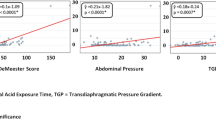Abstract
Introduction
Pathophysiology of gastroesophageal reflux disease (GERD) is multifactorial. An increased transdiaphragmatic pressure gradient (TPG) may be a main element for GERD in the obese patient. This study aims to evaluate the role of TPG in the physiopathology of GERD in obese individuals.
Methods
We studied 47 unselected consecutive candidates for bariatric operations (body mass index (BMI) > 35). All patients underwent high-resolution manometry and esophageal pH monitoring. Individuals were grouped as GERD + or GERD − based on DeMeester score. Abdominal pressure (AP) and thoracic pressure (TP), transdiaphragmatic pressure gradient (AP-TP), and lower esophageal sphincter (LES) retention pressure (LES basal pressure-TPG) were determined. Manometric variables were compared with a group of 20 lean healthy individuals (BMI < 25).
Results
There were 27 (57%) GERD + patients and 20 (43%) GERD − patients. TPG, waist circumference, LES retention pressure, and AP were higher in GERD + group as compared with GERD − individuals. GERD − group had manometric parameters similar to controls except for AP. GERD + patients had higher AP and TPG and lower LES retention pressure compared with controls. TPG and LES retention pressure correlated with waist circumference and DeMeester score. BMI correlated with AP but not with waist circumference or DeMeester score.
Conclusion
In the obese, GERD presence and severity were associated to a high TPG due to increase AP that correlates with waist circumference.

Similar content being viewed by others

Abbreviations
- GERD:
-
Gastroesophageal reflux disease
- TPG:
-
Transdiaphragmatic gradient pressure
- LES:
-
Lower esophageal sphincter
- LESRP:
-
LES retention pressure
- GEJ:
-
Gastroesophageal junction
- DCI:
-
Distal contractile integral
- R:
- LES:
-
Lower esophageal sphincter
References
Nadaleto BF, Herbella FA, Patti MG. Gastroesophageal reflux disease in the obese: pathophysiology and treatment. Surgery. 2016;159(2):475–86. https://doi.org/10.1016/j.surg.2015.04.034.
Fisichella PM, Patti MG. Gastroesophageal reflux disease and morbid obesity: is there a relation? World J Surg. 2009;33(10):2034–8.
Wilson LJ, Ma W, Hirschowitz BI. Association of obesity with hiatal hernia and esophagitis, Am J Gastroenterol. 1999;94:2840–4.
Schneider JH, Keuper M, Keonigsrainer A, et al. Transient lower esophageal sphincter relaxation in morbid obesity. Obes Surg. 2009;19:595–600.
Herbella FA, Sweet MP, Tedesco P, et al. Gastroesophageal reflux disease and obesity. Pathophysiology and implications for treatment. J Gastrointest Surg. 2007;11(3):286–90.
Tack J, Pandolfino JE. Pathophysiology of Gastroesophageal reflux disease. Gastroenterology. 2018;154(2):277–88. https://doi.org/10.1053/j.gastro.2017.09.047.
Ueda H, Yagi T, Amitani H, et al. The roles of salivary secretion, braingut peptides, and oral hygiene in obesity. Obes Res Clin Pract. 2013;7:e321–9.
Del Grande LM, Herbella FAM, Katayama RC, Schlottmann F, Patti MG. The role of the transdiaphragmatic pressure gradient in the pathophysiology of gastroesophageal reflux disease. Arq Gastroenterol. 2018; 55suppl 1(Suppl 1):13–17.
de Vries DR, van Herwaarden MA, Smout AJ, et al. Gastroesophageal pressure gradients in gastroesophageal reflux disease: relations with hiatal hernia, body mass index, and esophageal acid exposure. Am J Gastroenterol. 2008;103(6):1349–54.
Mitchell DR, Derakhshan MH, Wirz AA, et al. Abdominal compression by waist belt aggravates gastroesophageal reflux, primarily by impairing esophageal clearance. Gastroenterology. 152(8):1881–8. https://doi.org/10.1053/j.gastro.2017.02.036.
Fass R. The pathophysiological mechanisms of GERD in the obese patient. Dig Dis Sci. 2008;53:2300–6.
Moraes-Filho JP, Chinzon D, Eisig JN, et al. Prevalence of heartburn and gastroesophageal reflux disease in the urban Brazilian population. ArqGastroenterol. 2005;42(2):122–7.
Chang P, Friedenberg F. Obesity and GERD. Gastroenterol Clin N Am. 2014;43(1):161–73. https://doi.org/10.1016/j.gtc.2013.11.009.
El-Serag HB, Tran T, Richardson P, et al. Anthropometric correlates of intragastric pressure. Scand J Gastroenterol. 2006;41:887–91.
Fornari F, Madalosso CA, Farré R, et al. The role of gastro-oesophageal pressure gradient and sliding hiatal hernia on pathological gastro-oesophageal reflux in severely obese patients. Eur J Gastroenterol Hepatol. 2010;22(4):404–11.
Steier J, Lunt A, Hart N, et al. Observational study of the effect of obesity on lung volumes. Thorax. 2014;69(8):752–9. https://doi.org/10.1136/thoraxjnl-2014-205148.
Sabaté JM, Jouët P, Merrouche M, et al. Gastroesophageal reflux in patients with morbid obesity: a role of obstructive sleep apnea syndrome? Obes Surg. 2008;18(11):1479–84. https://doi.org/10.1007/s11695-008-9508-9.
Pandolfino JE, El-Serag HB, Zhang Q, et al. Obesity: a challenge to esophagogastric junction integrity. Gastroenterology. 2006;130(3):639–49.
Côté-Daigneault J, Leclerc P, Joubert J, et al. High prevalence of esophageal dysmotility in asymptomatic obese patients. Can J Gastroenterol Hepatol. 2014;28(6):311–4.
Valezi AC, Herbella FA, Junior JM, et al. Esophageal motility after laparoscopic Roux-en-Y gastric bypass: the manometry should be preoperative examination routine? Obes Surg. 2012;22(7):1050–4. https://doi.org/10.1007/s11695-012-0613-4.
Author information
Authors and Affiliations
Contributions
Conception and design, acquisition of data, analysis and interpretation of data, drafting the article: LMDG, FAMH
Acquisition of data, review for intellectual content, final approval of the version to be published: RCK, WGL
Conception and design, review for intellectual content, final approval of the version to be published: MGP
Corresponding author
Ethics declarations
Conflict of Interest
The authors declare that they have no conflict of interest.
Additional information
Publisher’s Note
Springer Nature remains neutral with regard to jurisdictional claims in published maps and institutional affiliations.
Quickshot presentation at the 60th SSAT Annual meeting, San Diego, US, May, 2019
Electronic Supplementary Material
ESM 1
(PDF 193 kb)
Rights and permissions
About this article
Cite this article
de Mello Del Grande, L., Herbella, F.A.M., Katayama, R.C. et al. Transdiaphragmatic Pressure Gradient (TPG) Has a Central Role in the Pathophysiology of Gastroesophageal Reflux Disease (GERD) in the Obese and it Correlates with Abdominal Circumference but Not with Body Mass Index (BMI). OBES SURG 30, 1424–1428 (2020). https://doi.org/10.1007/s11695-019-04345-x
Published:
Issue Date:
DOI: https://doi.org/10.1007/s11695-019-04345-x


